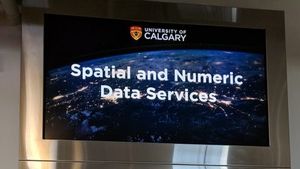One of the primary characteristics of current change is that the network is ‘coming inside’: it is becoming a part of routine activities and they are being reconfigured in the process. This is happening everywhere, and in science it goes under the name of ‘e-science’ or ‘cyberinfrastructure’.
The UK Research Councils define e-science thus:
What is meant by e-Science? In the future, e-Science will refer to the large scale science that will increasingly be carried out through distributed global collaborations enabled by the Internet. Typically, a feature of such collaborative scientific enterprises is that they will require access to very large data collections, very large scale computing resources and high performance visualisation back to the individual user scientists. [Research Councils UK: e-Science]
This quote is from their e-science website and the links from this page point to a range of indicative activities.
In the US, the Office of Cyberinfrastructure established by the NSF plans to fund activities in similar areas. Its website points to funding initiatives, and a range of documents and reports. Including a vision statement for ‘NSF’s cyberinfrastructure for 21st Century discovery’ [pdf]. There has also been recent exploration of these issues in the context of the humanities and social sciences also and the ACLS Commission on Cyberinfrastructure for the Humanities and Social Sciences has released a draft final report.
In this context, here are a few recent UK resources of potential interest.
- The Digital Curation Centre has produced a short briefing paper on data curation:
Curation of data collected and developed during these investigations is vital for post-analysis results verification, further experimentation and cumulative analysis. Yet despite its importance, usually only a very small percentage of outputs are properly managed and curated for re-use. Failure to properly curate means that investments are not maximised, research cannot be validated or reliably extended, and may even result in data loss and incorrect interpretation. Vigorous curation practices should be implemented to address these risks, ensure data provenance and integrity, and enable reliable re-use. The scale and importance of the research means a holistic and interoperable approach to curating research outputs is required. Ultimately, this is an issue that can only be addressed on a collaborative scale, like the Grid itself, and requires input from all stakeholders across the entire data life-cycle. [Digital Curation Centre: Resource Centre: Briefing Papers: Curating e-Science Data]
This is one of several briefing papers published by the DCC, including ones on the curation of email and geospatial data respectively.
- The Research Information Network ran an event called Data webs: new visions for research data on the web with presentations from Europe and the US. From the blurb: “The event provided an opportunity to examine and discuss the changing nature of scholarly publication and the use of lightweight Semantic Web and Web 2.0 approaches to improve access to, and interoperability between scientific research data”. The presentations are available and are a useful overview of issues.
- The Arts and Humanities Data Service has been exploring how e-science techniques and approaches might be of use in the arts and humanities. Outputs from their E-science scoping study are available on their website.
The nature of its support for e-science is one of the major challenges facing the research library in coming years, and there is no real consensus about response. Nor is there a clear sense of requirement coming through these various resources. I noticed a comment in the opening Data Web presentation. David Shotton [ppt] spoke about how typing pools gave way to self-created word processing, and about how telephone switchboards gave way to dialling one’s own international calls. He suggests that librarians are being similarly bypassed by ‘on-line journals’. He goes on to talk about how the database will give way to a ‘distributed dataspace’ as we enter the age of ‘distributed personal data publication’.
ARL has a working group – Library support for e-science – which is exploring these issues. A part of its charge reads:
Engaging ARL members in the development of new roles for libraries as e-science infrastructure and service needs emerge at research institutions and promoting the contributions of research libraries in this arena. [home]
I look forward to seeing their recommendations.
(Incidentally, I notice that Richard Akerman is keeping a set of relevant links on Connotea under the name of the ARL group.)
Related entries:



